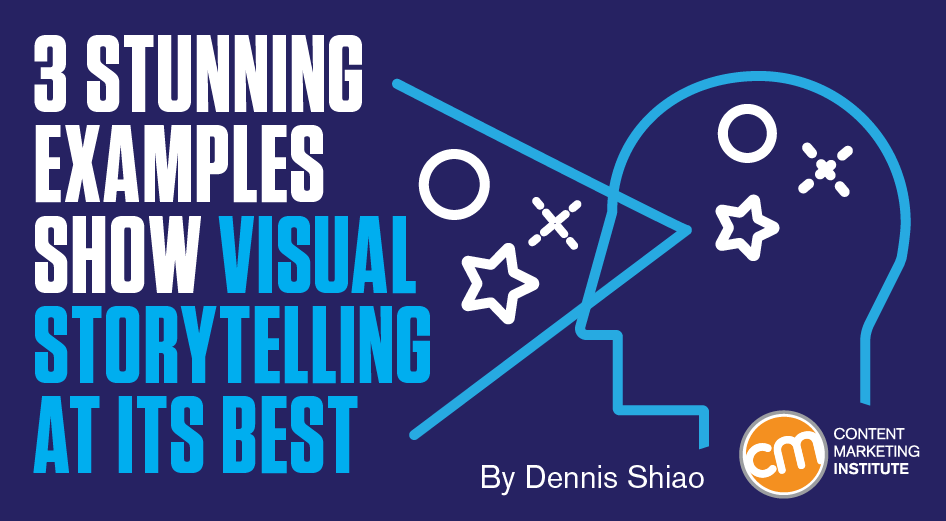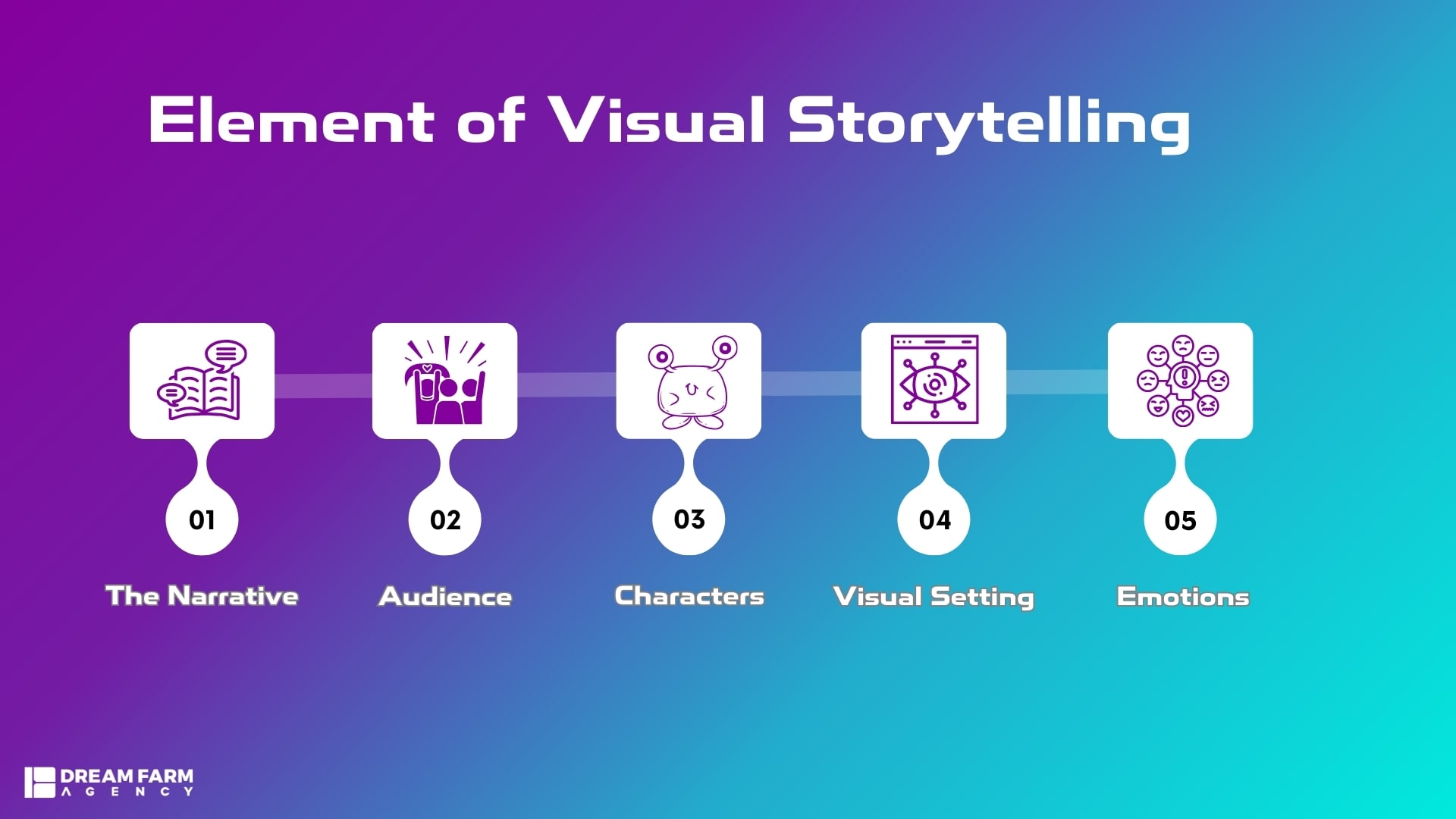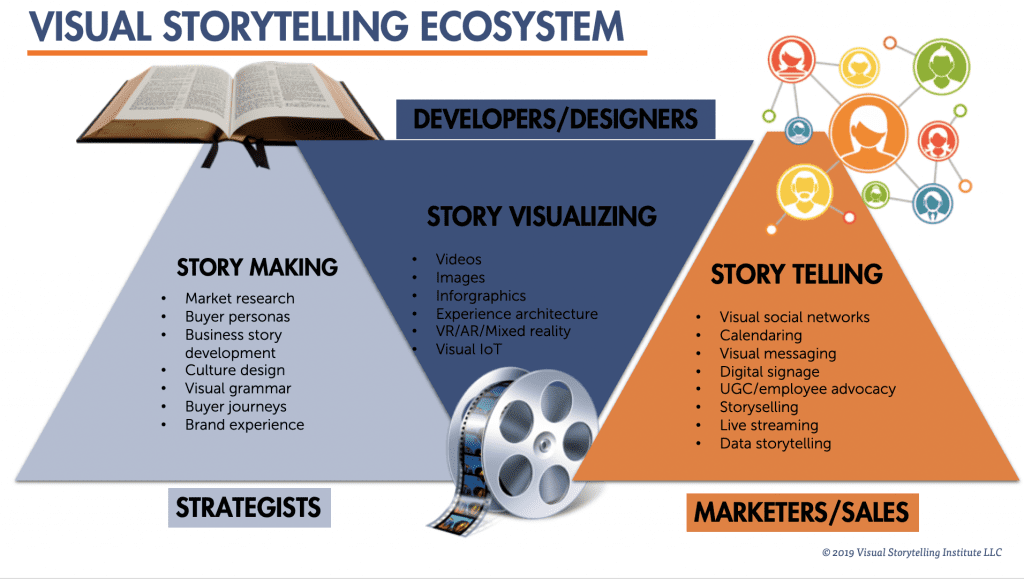Visual storytelling is a powerful way to convey messages. It uses images and videos to communicate ideas effectively.
In today’s digital age, our attention spans are shorter. People prefer visual content over text. Visual storytelling taps into this preference. It combines visuals with narratives to engage audiences. This method is impactful in marketing, education, and entertainment. By using visuals, stories become more memorable.
They evoke emotions and make complex ideas easier to understand. Whether you’re a marketer, educator, or content creator, mastering visual storytelling can enhance your communication. Dive in to learn how to craft compelling stories that captivate and inspire.

Credit: contentmarketinginstitute.com
Introduction To Visual Storytelling
Visual storytelling is an art. It conveys a narrative through images, videos, or graphics. It engages viewers on a deeper emotional level. This method of storytelling has become essential in today’s digital era. It helps in connecting with audiences more effectively.
What Is Visual Storytelling?
Visual storytelling is the technique of using visual media to tell a story. This can include photos, illustrations, videos, infographics, and more. The goal is to communicate a message or idea through visuals.
For example, a photo series can tell a powerful story without a single word. Similarly, a video can convey complex emotions and narratives. Visual storytelling combines creativity and technology. It’s a blend of art and communication.
Importance Of Visual Narratives
Visual narratives are crucial for several reasons. First, they capture attention quickly. In a world full of information, visuals stand out. They can convey messages faster than text.
Second, visuals are more memorable. People remember stories better when they see them. This makes visual storytelling a powerful tool for education and marketing.
Third, visuals evoke emotions. A well-crafted image or video can make viewers feel something. This emotional connection is key to effective communication.
In summary, visual storytelling enhances engagement, memory, and emotional impact. It’s a valuable skill for anyone looking to communicate effectively.
Elements Of A Compelling Visual Story
Creating a compelling visual story involves several key elements. These elements help to capture the audience’s attention and convey the message effectively. Let’s explore the vital components that make a visual story engaging.
Imagery And Graphics
Imagery and graphics are the foundation of visual storytelling. High-quality images can tell a story without words. They convey emotions, set the tone, and provide context.
- High-resolution images: Ensure your images are clear and sharp.
- Relevant graphics: Use graphics that support your story’s theme.
- Color schemes: Choose colors that evoke the desired emotions.
Using infographics can help present complex information in an easy-to-understand format. Visual elements should be consistent and align with the story’s message.
Characters And Emotions
Characters and emotions are crucial for connecting with the audience. Characters should be relatable and evoke empathy. Their emotions drive the narrative and make the story memorable.
- Relatable characters: Create characters that the audience can identify with.
- Emotional expressions: Show emotions through facial expressions and body language.
- Character development: Ensure your characters grow throughout the story.
Emotional storytelling helps the audience feel invested in the story. Highlighting characters’ emotions can create a deeper connection and enhance the storytelling experience.
Crafting Your Visual Narrative
Visual storytelling is a powerful way to share your message. It combines images, graphics, and text to tell a story. Crafting a visual narrative requires careful planning and creativity. This section will guide you through the essential steps to create compelling visual stories.
Storyboarding Techniques
Storyboarding helps you plan your visual narrative. It involves sketching out each scene or shot. This process ensures your story flows smoothly.
Here are some effective storyboarding techniques:
- Thumbnail Sketches: Create small, quick sketches of each scene.
- Detailed Panels: Add more detail to important scenes.
- Annotations: Include notes about camera angles, lighting, and dialogue.
Storyboarding helps you visualize the entire story before you start creating. It saves time and helps avoid mistakes.
Design Principles
Good design is essential for effective visual storytelling. Use these design principles to enhance your narrative:
| Design Principle | Description |
|---|---|
| Contrast | Use different colors, sizes, and shapes to create interest. |
| Alignment | Align elements to create a clean, organized look. |
| Repetition | Repeat elements to create unity and consistency. |
| Proximity | Group related items together to show their connection. |
Applying these principles makes your visual story more engaging and easier to understand.
Combine storyboarding and design principles to craft a compelling visual narrative. This approach ensures your story is both visually appealing and well-structured.

Credit: dreamfarmagency.com
Choosing The Right Medium
Visual storytelling involves many mediums. Choosing the right one can elevate your narrative. Some popular options are photography, illustration, videos, and animations. Each medium has its unique strengths and weaknesses. Understanding these can help you make an informed decision.
Photography Vs. Illustration
Photography captures real-life moments. It is great for authentic and relatable stories. People often connect with real images. They can see themselves in the story. It works well for news, events, and lifestyle content.
Illustration offers creativity and flexibility. It can bring abstract ideas to life. Illustrations can simplify complex concepts. They are perfect for educational content. They also add a unique, artistic touch to your story.
| Photography | Illustration |
|---|---|
| Real-life moments | Creative and flexible |
| Relatable and authentic | Abstract ideas |
| News and events | Educational content |
Videos And Animations
Videos combine visuals, sound, and motion. They create an engaging experience. Videos can convey emotions effectively. They are ideal for storytelling. They work well for tutorials, interviews, and vlogs.
Animations bring stories to life with motion graphics. They can simplify complex topics. Animations are visually appealing. They are perfect for explainer videos and ads. They also work well for entertainment.
- Videos:
- Combines visuals, sound, and motion
- Engaging experience
- Effective emotion conveyance
- Ideal for tutorials, interviews, vlogs
- Animations:
- Motion graphics bring stories to life
- Simplify complex topics
- Visually appealing
- Perfect for explainer videos, ads, entertainment
Engaging Your Audience
Visual storytelling captivates and engages your audience in ways that words alone cannot. By leveraging visuals, you can create a deeper connection and hold your audience’s attention longer. Below, we will discuss key strategies to enhance audience engagement through visual storytelling.
Emotional Connection
People remember stories that make them feel something. An emotional connection is crucial in visual storytelling. Use images and videos that evoke strong emotions. This can be happiness, sadness, surprise, or even anger.
For example, a photo of a joyful child playing can evoke happiness and nostalgia. Similarly, a video showing a family reunion can bring tears to the eyes. Use color schemes and music to enhance these emotional cues.
- Use relatable characters: People connect more with characters they can relate to.
- Show real-life situations: Authenticity helps in building trust and connection.
- Use powerful visuals: Strong visuals can evoke stronger emotions.
Interactive Elements
Interactive elements engage your audience actively rather than passively. This increases their involvement and interest in your story. Consider adding interactive elements like quizzes, polls, and clickable images.
For example, a clickable infographic allows users to explore different parts of the story. A quiz can make the story more engaging and personalized. Interactive videos where users can choose the story path are also effective.
- Quizzes and Polls: These make the audience think and participate.
- Clickable Infographics: These help in breaking down complex information.
- Interactive Videos: These offer a more immersive experience.
| Engagement Strategy | Benefit |
|---|---|
| Emotional Connection | Builds a deeper connection with the audience |
| Interactive Elements | Increases audience involvement and interest |

Credit: www.visualstorytell.com
Case Studies Of Successful Visual Stories
Visual storytelling is a powerful tool. It captivates audiences and conveys messages effectively. Various brands and organizations have harnessed this power. Here are some case studies of successful visual stories.
Brand Campaigns
Brands use visual storytelling to connect with their audience. A well-known example is Coca-Cola’s “Share a Coke” campaign.
- Campaign: Share a Coke
- Brand: Coca-Cola
- Objective: Increase engagement and sales
Coca-Cola replaced its logo with popular names. This simple change made the product personal. People shared photos with their personalized bottles. It created a social media buzz. Sales increased by 2% in the U.S. alone.
Another successful example is Airbnb’s “We Accept” campaign.
- Campaign: We Accept
- Brand: Airbnb
- Objective: Promote inclusivity and diversity
Airbnb used visuals to tell stories of acceptance. They featured diverse hosts and guests. The campaign resonated with many. It strengthened Airbnb’s brand image.
Non-profit Initiatives
Non-profits also use visual storytelling to spread their message. A notable example is the “Ice Bucket Challenge” by ALS Association.
- Campaign: Ice Bucket Challenge
- Organization: ALS Association
- Objective: Raise awareness and funds for ALS research
The campaign involved people dumping ice water on themselves. They posted videos and nominated others to do the same. The challenge went viral. It raised over $115 million for ALS research.
Another impactful example is WWF’s “Last Selfie” campaign.
- Campaign: Last Selfie
- Organization: WWF
- Objective: Raise awareness about endangered species
WWF used Snapchat to share “selfies” of endangered animals. The images had a message saying, “Don’t let this be my last selfie.” The campaign was impactful and shared widely. It raised awareness and funds for conservation efforts.
Tools And Resources
Visual storytelling is a powerful tool for capturing and retaining audience attention. With the right tools and resources, anyone can create compelling visual stories. In this section, we’ll explore some essential tools and resources that can enhance your visual storytelling skills.
Software And Apps
The right software and apps can make a big difference in your visual storytelling. Here are some popular choices:
- Adobe Creative Cloud: A suite of applications for graphic design, video editing, and web development. Popular tools include Photoshop, Illustrator, and Premiere Pro.
- Canva: A user-friendly design tool ideal for creating social media graphics, presentations, and other visual content. It offers a variety of templates and design elements.
- Procreate: A powerful digital painting app for iPad, favored by artists and illustrators for its intuitive interface and extensive brush library.
- Final Cut Pro: A professional video editing software for Mac users, known for its advanced editing features and seamless integration with other Apple products.
Online Courses And Tutorials
Learning new skills is essential for effective visual storytelling. These online courses and tutorials can help you improve your craft:
- Udemy: Offers a wide range of courses on visual storytelling, graphic design, and video editing. Courses are taught by industry professionals and cover various skill levels.
- Skillshare: Provides thousands of classes on creative skills, including illustration, animation, and photography. Many courses offer hands-on projects and peer feedback.
- Coursera: Partners with top universities and organizations to offer courses on visual storytelling, filmmaking, and digital media. Many courses provide certificates upon completion.
- YouTube: A vast library of free tutorials on every aspect of visual storytelling. Channels like “Film Riot” and “Gareth David Studio” offer high-quality content.
Measuring The Impact
Measuring the Impact of visual storytelling is crucial. It helps you understand how effective your content is. This section breaks down two key methods: audience feedback and analytics.
Audience Feedback
Gathering audience feedback is essential for understanding the impact. There are several ways to collect this data:
- Surveys: Send short surveys to your audience. Ask them about their experience.
- Comments: Monitor comments on your posts. Look for positive or negative reactions.
- Social Media: Use polls on platforms like Twitter or Instagram. Engage with your audience directly.
These methods help you gauge how your audience feels. Positive feedback means your visual story resonates. Negative feedback can offer areas for improvement.
Analytics And Metrics
Analytics and metrics provide quantitative data on your visual storytelling’s impact. Here are some key metrics to track:
| Metric | Description |
|---|---|
| Views | Number of times your content is viewed. |
| Engagement | Likes, shares, and comments on your content. |
| Click-Through Rate (CTR) | Percentage of viewers who click on links in your content. |
| Conversion Rate | Percentage of viewers who take a desired action. |
Use tools like Google Analytics to track these metrics. These numbers show how your audience interacts with your content. High engagement rates indicate that your visual stories are compelling. Low conversion rates suggest that changes are needed.
Future Trends In Visual Storytelling
Visual storytelling is evolving rapidly. The future holds exciting trends that will change how we create and consume stories. Let’s explore two significant trends: Augmented Reality and Immersive Experiences.
Augmented Reality
Augmented Reality (AR) is blending digital elements with our real world. This technology enhances our storytelling by adding layers of information to our environment.
- Interactive Content: AR allows users to interact with the story. This makes it more engaging.
- Enhanced Visualization: It helps visualize complex concepts. Users can see and understand better.
- Real-time Updates: AR can provide real-time information. This keeps the story dynamic.
Industries like education, entertainment, and marketing are adopting AR. They are making their stories more compelling and informative.
Immersive Experiences
Immersive experiences take storytelling to the next level. They fully engage the audience’s senses, creating unforgettable experiences.
| Feature | Benefit |
|---|---|
| 360-Degree Videos | Viewers can explore the story from every angle. |
| Virtual Reality (VR) | Provides a fully immersive environment. |
| Soundscapes | Enhances the mood and emotion of the story. |
These immersive technologies create a deeper connection with the audience. They make the story more memorable.
Frequently Asked Questions
What Is Visual Storytelling?
Visual storytelling is the art of using images, videos, and graphics to convey a narrative. It engages the audience by combining visuals and text to create an immersive experience.
Why Is Visual Storytelling Important?
Visual storytelling is important because it captures attention and enhances engagement. It simplifies complex information, making it more digestible and memorable for the audience.
How Do You Create Visual Storytelling?
To create visual storytelling, start with a clear narrative. Use relevant images, videos, and graphics to support your story. Ensure consistency in style and design.
What Are Examples Of Visual Storytelling?
Examples include infographics, photo essays, short films, and social media stories. These formats combine visuals and text to create compelling narratives.
Conclusion
Visual storytelling captures attention and evokes emotions. It communicates messages quickly and effectively. Using images and videos enhances understanding. This method engages the audience deeply. It makes content memorable and shareable. Keep stories clear and concise. Focus on your audience’s needs and interests.
Consistent practice improves your storytelling skills. Remember, a picture is worth a thousand words. Embrace visual storytelling to connect with your audience.
Related posts:
- Tidycal for Businesses: Streamline Your Scheduling Efforts
- Tidycal Features: Streamline Your Scheduling Efforts
- Unlocking the Potential of the Merlin Lifetime Deal: An AI Tool for Creatives and Professionals
- Unlocking the Potential of the Merlin Lifetime Deal: An AI Tool for Creatives and Professionals
